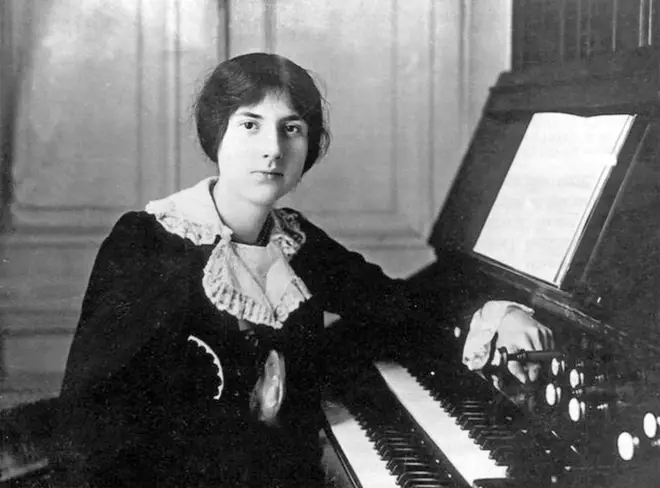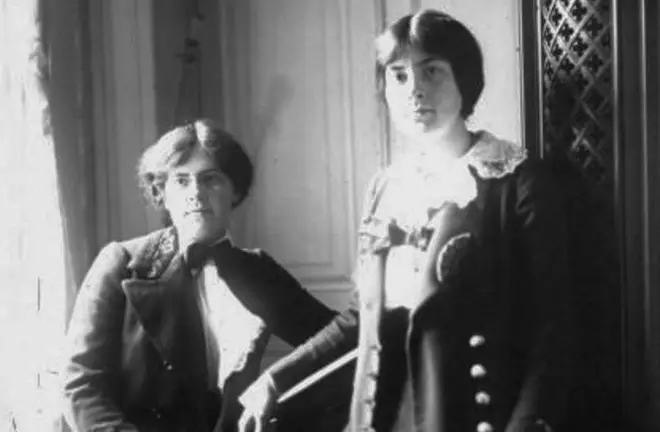It's all about the classical music composers and their works from the last 400 years and much more about music. Hier erfahren Sie alles über die klassischen Komponisten und ihre Meisterwerke der letzten vierhundert Jahre und vieles mehr über Klassische Musik.
Total Pageviews
Friday, August 25, 2023
Vanessa Williams - Save The Best For Last (Official Music Video)
THRILLMAKER: The Humperdinck is back!
BY JOEE GUILAS
AT A GLANCE
This September, thelegendary British crooner returnsto the country as part of hisongoing world tour, “The Legend Continues.” Fans will be serenaded by his passionate performances in a two-night concert at the Newport Performing Arts Theater, Newport World Resorts, Pasay City, on Sept. 9 and 10, 7:30 PM.

Ironic as it may sound, the singer who immortalized the song “Release Me” is not considering releasing his tight hold on fame anytime soon. Legendary balladeer and frequent Manila visitor Engelbert Humperdinck will soon be en route to another world tour, including a stop in the Philippines this September.
“It’s been four years since my last visit, and I’m looking forward to coming over. I’m excited about coming over there. I know that Filipinos love my music. I’ve been spending a lot of time online, and I see them singing my songs on karaoke,” shared Humperdinck. He said this also prompts him to always have something special for his Filipino fans whenever he is afforded the chance to visit the country. This next visit is undoubtedly not going to be an exception.
“I have a surprise for the Filipino people when I get there,” he teased.
The promised surprise is on top of the 87-year-old singer’s new album, "All About Love.” He hopes that some cuts in this new project will be hits just like his classic “Release Me,” which stayed on top of the charts for 56 consecutive weeks in multiple countries.
“The music that I record seems timeless when I recorded them in the past, and I never get tired singing them, especially Release Me,” Humperdinck acknowledged.
Asked whether or not he is getting tired of singing at his ripe age, Humperdinck stressed that slowing down anytime soon is far-fetched, at least at this point: “Retiring is not a word that I use. I have such a great following that I don’t want to disappoint them. Wherever I go, I get such a great reception.” More than this, however, the debt of gratitude to his craft makes him stick to the life of being a musician.
“Music has been my passport to the world. It’s made me see countries I’ve never seen before. It’s a wonderful way to make a living.”
This September, the legendary British crooner returns to the country as part of his ongoing world tour, “The Legend Continues.” Fans will be serenaded by his passionate performances in a two-night concert at the Newport Performing Arts Theater, Newport World Resorts, Pasay City, on Sept. 9 and 10, 7:30 PM.
For over 50 years, Humperdinck mastered wooing audiences worldwide, earning him the title “King of Romance.” Among his commercially successful singles are “Release Me,” “Quando Quando Quando,” “Spanish Eyes,” and many more.
While his captivating vocals have charmed millions of fans, the man earned his icon status in the music industry with massive achievements through the decades. Humperdinck rose in the music scene in the 1960s alongside iconic bands The Beatles and The Rolling Stones. Throughout his long career, he became a four-time Grammy nominee and released dozens of studio albums, selling over 150 million records. To this day, he consistently showcases his legacy and wins the hearts of listeners across the globe.
Now, given all these tucked into his belt, it should be no wonder why fans are finding it difficult to release his music from their playlists.

Ironic as it may sound, the singer who immortalized the song “Release Me” is not considering releasing his tight hold on fame anytime soon. Legendary balladeer and frequent Manila visitor Engelbert Humperdinck will soon be en route to another world tour, including a stop in the Philippines this September.
“It’s been four years since my last visit, and I’m looking forward to coming over. I’m excited about coming over there. I know that Filipinos love my music. I’ve been spending a lot of time online, and I see them singing my songs on karaoke,” shared Humperdinck. He said this also prompts him to always have something special for his Filipino fans whenever he is afforded the chance to visit the country. This next visit is undoubtedly not going to be an exception.
“I have a surprise for the Filipino people when I get there,” he teased.
The promised surprise is on top of the 87-year-old singer’s new album, "All About Love.” He hopes that some cuts in this new project will be hits just like his classic “Release Me,” which stayed on top of the charts for 56 consecutive weeks in multiple countries.
“The music that I record seems timeless when I recorded them in the past, and I never get tired singing them, especially Release Me,” Humperdinck acknowledged.
Asked whether or not he is getting tired of singing at his ripe age, Humperdinck stressed that slowing down anytime soon is far-fetched, at least at this point: “Retiring is not a word that I use. I have such a great following that I don’t want to disappoint them. Wherever I go, I get such a great reception.” More than this, however, the debt of gratitude to his craft makes him stick to the life of being a musician.
“Music has been my passport to the world. It’s made me see countries I’ve never seen before. It’s a wonderful way to make a living.”
This September, the legendary British crooner returns to the country as part of his ongoing world tour, “The Legend Continues.” Fans will be serenaded by his passionate performances in a two-night concert at the Newport Performing Arts Theater, Newport World Resorts, Pasay City, on Sept. 9 and 10, 7:30 PM.
For over 50 years, Humperdinck mastered wooing audiences worldwide, earning him the title “King of Romance.” Among his commercially successful singles are “Release Me,” “Quando Quando Quando,” “Spanish Eyes,” and many more.
While his captivating vocals have charmed millions of fans, the man earned his icon status in the music industry with massive achievements through the decades. Humperdinck rose in the music scene in the 1960s alongside iconic bands The Beatles and The Rolling Stones. Throughout his long career, he became a four-time Grammy nominee and released dozens of studio albums, selling over 150 million records. To this day, he consistently showcases his legacy and wins the hearts of listeners across the globe.
Now, given all these tucked into his belt, it should be no wonder why fans are finding it difficult to release his music from their playlists.
The Child Prodigies of Classical Music
From Hummel to Beethoven
In historical studies of music, compositions by children have generally not been held in high regard. The one exception, of course, is Wolfgang Amadeus Mozart, “commonly regarded as the child composer par excellence.” While the focus has so far been on childhood works by major composers, a recent publication by Barry Cooper has suggested, “that we might well look at the major works of all child composers regardless how they developed in later life.” And while it is easy to imagine a child composer writing a short song or piano piece, I was particularly interested in child composers producing large-scale compositions before the age of 16.
Johann Nepomuk Hummel
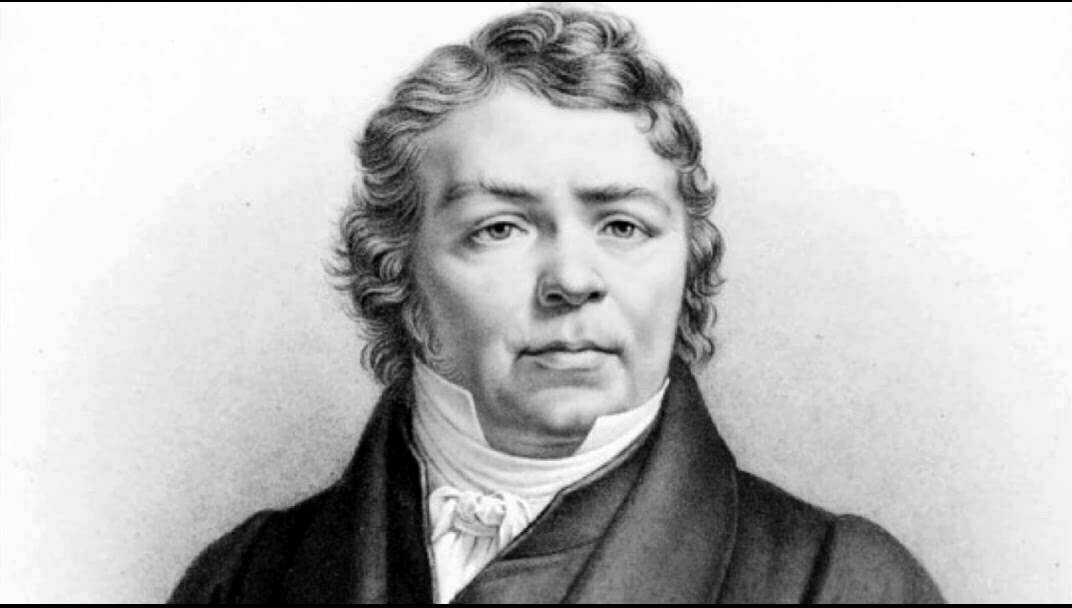
Johann Nepomuk Hummel
So let’s get started with our little survey of child prodigy composers with music by the 14-year-old Johann Nepomuk Hummel (1778-1837). Hummel studied with Mozart between the ages of eight and ten, and he composed a number of variations under Mozart’s tutelage. Once Hummel had moved to London, he published three sonatas for piano or harpsichord, two of them with violin or flute accompaniment. Hummel was only 14 at the time, “and he attracted a huge number of subscribers from London, Vienna, Prague, and countless other cities.
Gioachino Rossini
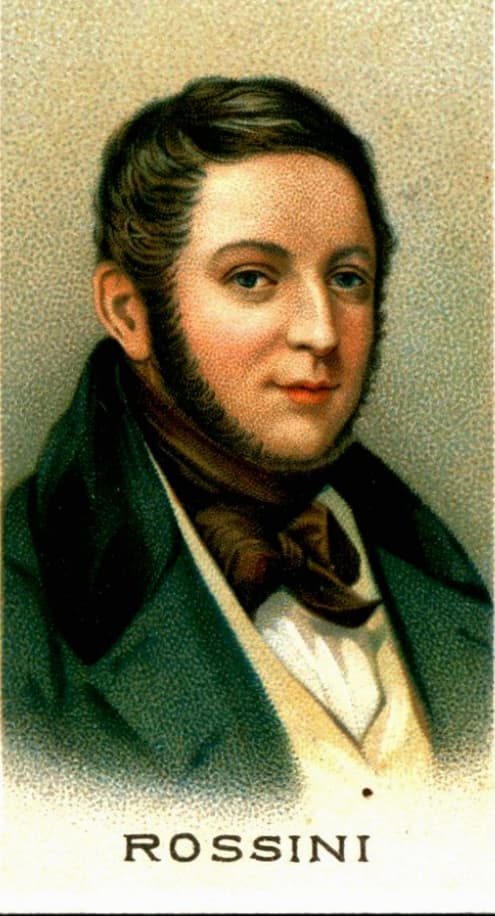
Gioachino Rossini
Gioachino Rossini (1792-1868) composed six string sonatas at the age of twelve in 1804. Scored for the unusual combination of two violins, cello, and double bass, “they are among the most successful works ever written by any child.” Rossini was familiar with the works of Mozart and Haydn, but it still seems incredible how these sonatas anticipate much of the sparkle of his later works. He composed them for a young merchant and claimed to have been ignorant of harmony when he wrote them. Actually, he described them as “horrendous,” and claimed to have written them within three days. However, Rossini could not deny his own personal style, including a characteristic melodic style, the use of crescendos, and the occasional use of the double bass as a kind of buffo character. These sonatas do show some surprisingly inventive and unusual features, “including unexpected keys and modulations, and spiced up percussive cross-relations.”
Georges Enescu
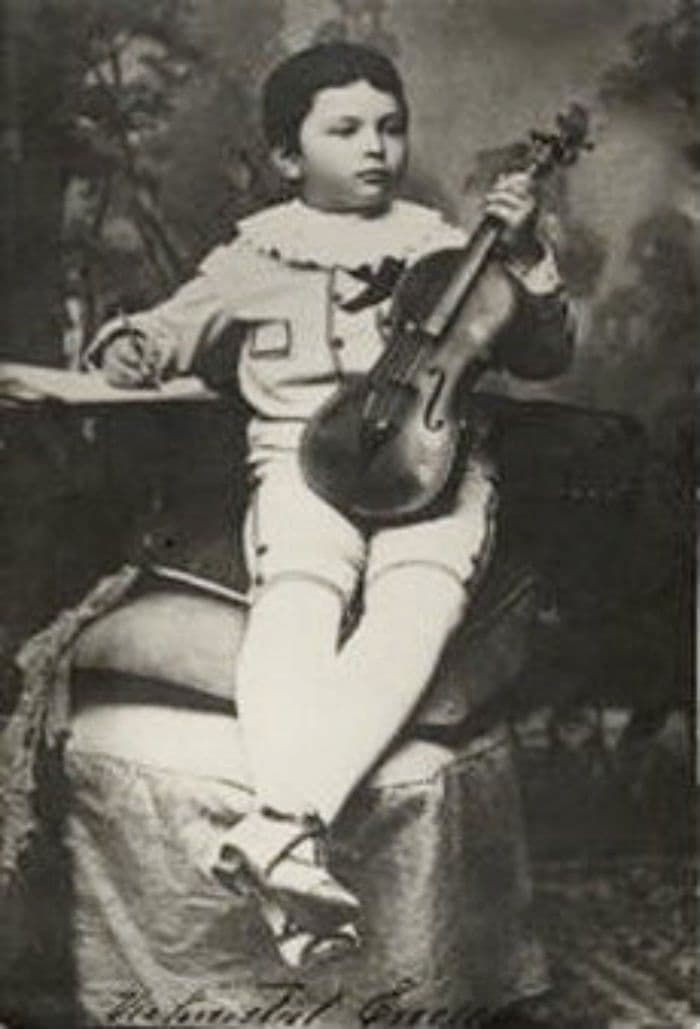
The young Georges Enescu at 3 years old
Yehudi Menuhin described Georges Enescu (1881-1955) as “the greatest musician I have ever experienced.” Such high praise is actually not surprising as Enescu had composed at least fifty works by the time he reached the age of sixteen. Almost habitually, a composer’s career is viewed as one of growth and improvements, “with the implication that early works have little or no interest.” They are often dismissed as “juvenilia,” and accorded a secondary place within the overall oeuvre. Suggestions of immaturity and youthful doodling, however, are completely out of place when speaking of Enescu. By 1895, if not before, he was “already a thorough master of the art of composition.” Enescu composed 4 Study Symphonies, and Massenet described the first symphony in D minor, as “very remarkable, extraordinary for his instinct for development.” As Cooper observes, “none of the works produced before 1897 seem to have been written with publication in mind, and indeed nearly all of them are still unpublished, though thankfully Enescu preserved the manuscripts of most of them and they are now in the Enescu Museum in Bucharest.
Frederick Arthur Gore Ouseley
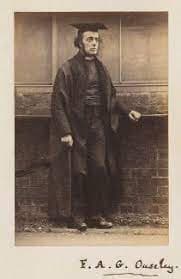
Frederick Arthur Gore Ouseley
I must confess that before reading Cooper’s book on children composers, the name Frederick Arthur Gore Ouseley (1825-1889) was not known to me. As it turns out, Ouseley is “possibly the youngest child ever to compose a complete and coherent piece of music that still survives.” According to an anecdote, a very young Ouseley famously asked his father why he blew his nose in G. His father had been ambassador to Russia and Persia, and his earliest work is dated 18 November 1828, when he was aged three years and ninety-eight days. It was published many years later. These early pieces were written down by his sister Mary Jane, as Ouseley began composing long before he learned to write, “but his sister appears not to have attempted to correct his music in any way. Ouseley composed his first opera, Tom and His Mama in 1832, and most of his childhood compositions still survive, albeit only in manuscript. None of these early pieces seem to have been properly recorded. As such, I decided to feature a Prelude and Fugue written during his tenure as Vicar of St. Michael’s Tenbury as well as Warden of the College.
Muzio Clementi
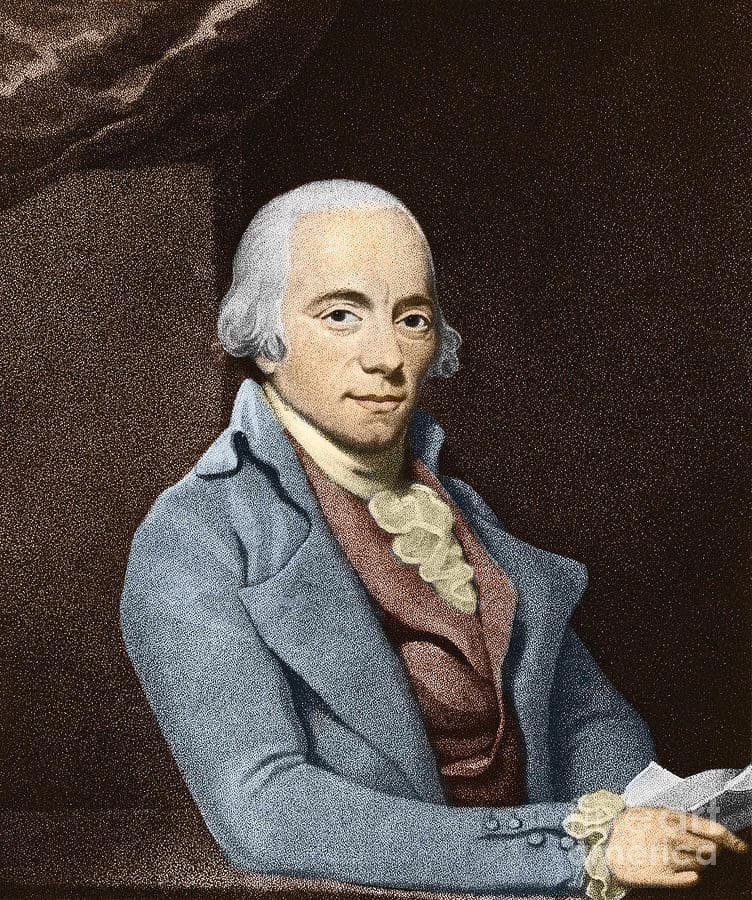
Muzio Clementi
Musicologists have discovered that Muzio Clementi (1752-1832) composed a full-scale oratorio at the age of 12. The libretto does survive in a printed source of 1764, but the music has sadly been lost. It’s almost certain that there must have been a number of additional compositions, “as the oratorio is most unlikely to be the first thing he ever wrote. Clementi’s earliest surviving work is the Sonata per cembalo in A flat major, dated 1765. The music was not published in the composer’s lifetime, but it is identified “on the manuscript as No. 20, suggesting Clementi’s prolific activity as a composer at the age of thirteen.” In three movements, the sonata, typical in many ways of its period, demonstrates Clementi’s early technical competence, with an opening classical Allegro, followed by a contrasting slow movement and a rapid finale. As a critic writes, “The sonata is a well-constructed work in which each movement explores the structural distinction between binary form and sonata form in a different way. The finale is particularly successful, with broken-chord motifs exploited in a variety of ways.”
Samuel Wesley
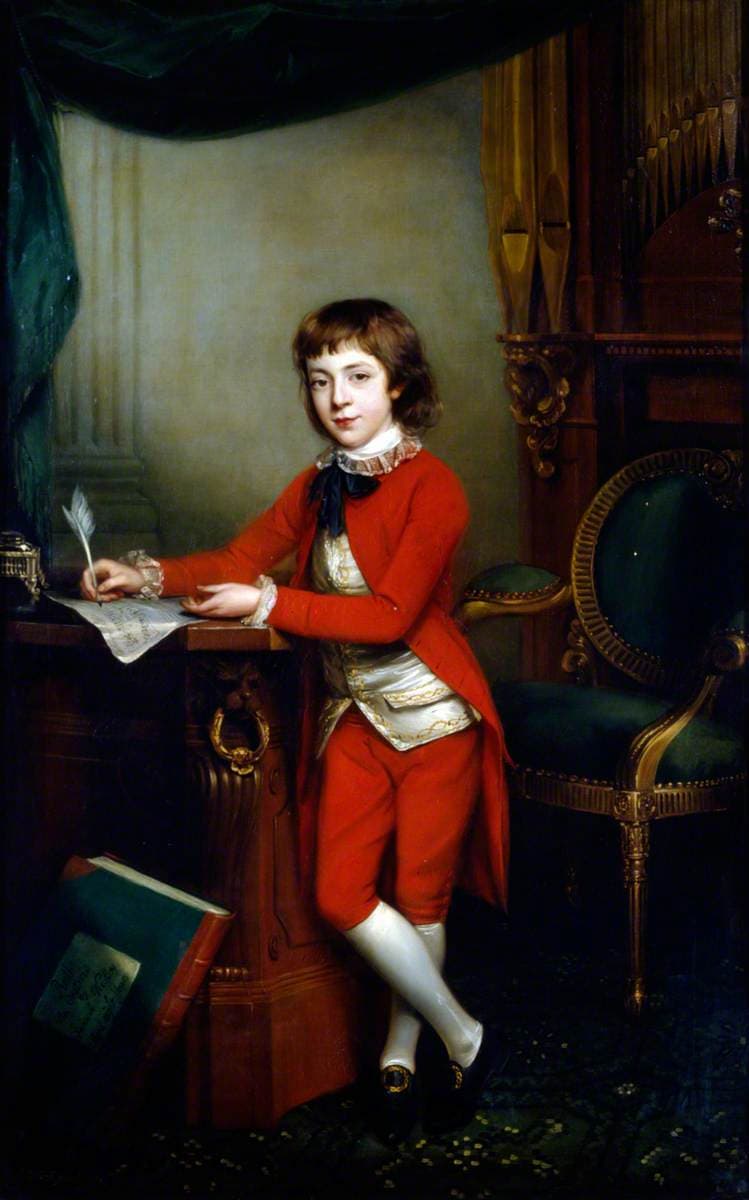
Samuel Wesley
Samuel Wesley (1766-1837) was the younger son of the divine and hymn-writer Charles Wesley (1707-1788), “the sweet singer of Methodism,” and a nephew of John Wesley, the evangelist and leader of Methodism (1703-1791). Samuel appears to have been one of the most prolific and gifted of all child composers, “as he composed more than one hundred works by the age of sixteen. By the age of eight, Wesely had crafted the oratorio Ruth, even though it was reported that much of the work had been composed up to two years earlier. A second oratorio was completed shortly thereafter. The “Sinfonia Obligato” for violin, cello and organ, with an orchestra of strings and two horns, with ad libitum timpani is dated 27 February 1781. The unusual solo grouping is used in the outer movements, and the technical demands on the three players are considerable. As Cooper observes, “By the age of sixteen Wesley had a formidable basis for developing into a truly great composer, unfortunately, he did not fulfill his potential, and the reason may be largely his own fault.” In addition, a head injury and lack of proper training prevented him from achieving his full potential.
Sergei Prokofiev
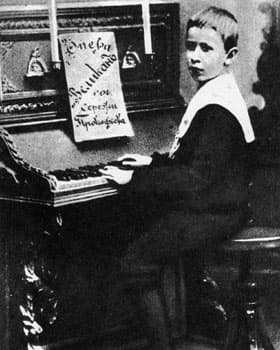
Sergei Prokofiev in 1900
Sergei Prokofiev’s (1891-1953) early compositions already show a preference for ostinato and terrifying effects. His earliest known composition is titled “Indian Galop,” and dates from the summer of 1896. As in many cases with child composers, his mother wrote it down, as the child had not yet grasped musical notation. Prokofiev continued to compose further piano pieces throughout his childhood, totaling roughly eighty works by the time he reached the age of sixteen. By 1902, Prokofiev had completed a symphony in G with the help of his teacher Reinhold Gliére. “Altogether, sixty-one pages of this symphony survive in score, including a fully orchestrated first movement and the rest in short score.” As has been suggested, however, more significant than his instrumental compositions were his early attempts at writing operas. Velikan (The Giant) dates from February to about June 1900. It is written in vocal score and divided into three acts of seven scenes. “Velikan is notable for some extreme dynamics and some powerful music for the Giant, whose footsteps are portrayed by loud, ponderous chords that uncannily foreshadow the heavy chords accompanying the main theme in ‘The Montagues and the Capulets’ in Prokofiev’s Romeo and Juliet.”
Max Bruch
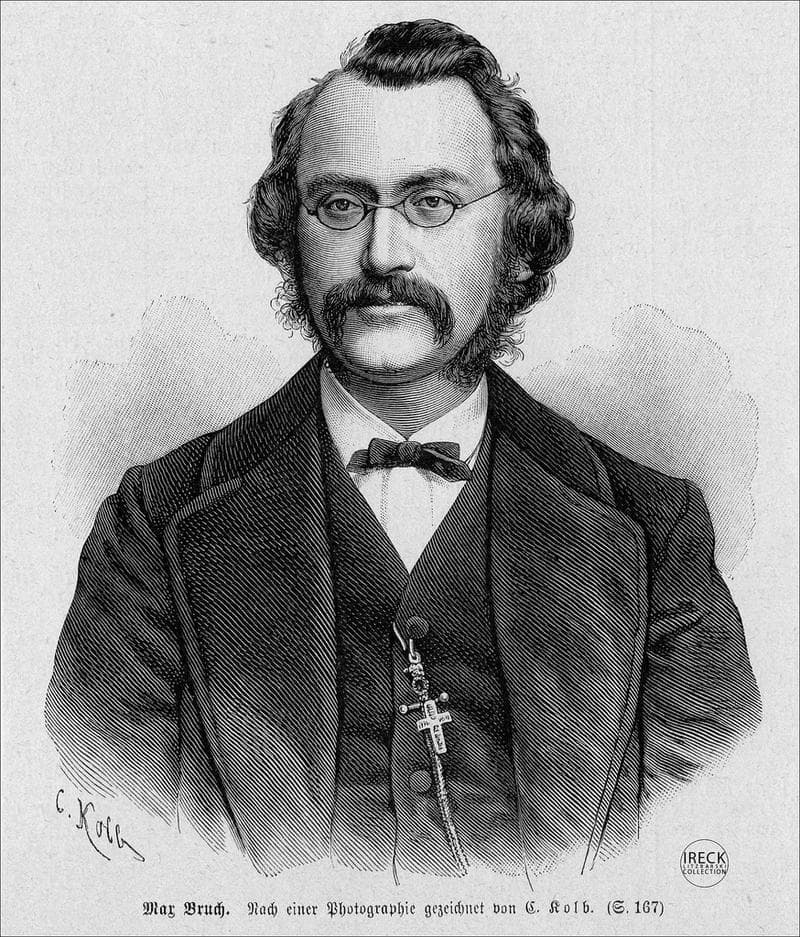
Max Bruch
The Septet in E-flat Major by Max Bruch (1838-1920) was only published in 1987, but it was composed in 1849, when Bruch was only 11 years old. Apparently, his first composition was written at the age nine for his mother’s birthday. “Soon he composed prolifically, producing motets, psalms, piano pieces, violin sonatas, a string quartet, and even orchestral works while still a child.” Almost all these early works, which also include two piano trios and lieder, have been lost. The four movements of the septet, scored for clarinet, horn, bassoon, two violins, cello, and double bass, reveal a surprising maturity. His innate musical sensitivity allowed him to orchestrate and create melodic inventions with consummate skill. Remarkable for a composer his age, Bruch creates enchanting effects, which are in marked contrast to the virtuoso elements of the work. Without doubt, this youthful composition “bears clear features of Bruch’s later style, and much skill in form and harmonic planning.”
George Frideric Handel
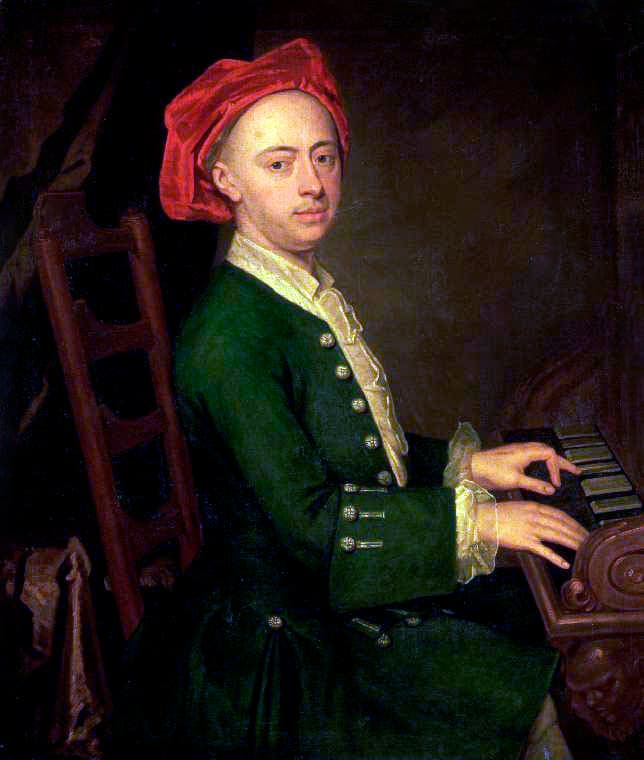
George Frideric Handel
George Frideric Handel (1685-1759) apparently composed prolifically during his childhood. He is said to have written weekly compositions for the church in Halle, but none of these early works have seemingly survived. As with many other works of Handel, we are dealing with questions of authenticity when it comes to his childhood works. He is supposed to have written six oboe sonatas at the age of eleven, “works that display occasional touches of originality.” When Handel was shown a copy of the sonatas in England many years later, he actually confirmed the authenticity of the Sonatas. He also confessed that he enjoyed writing music for the oboe. “Since they do not differ greatly in style from his later music, there seem no very reliable grounds, external or internal, for dismissing the attribution to Handel, as have been done by several recent scholars.” What makes these early works suspicious, I suppose, is that the “exhibit characteristic melodic imagination and contrapuntal skill along with Handel’s renowned ability at developing whole movements out of two or three seemingly insignificant motifs.”
Ludwig van Beethoven
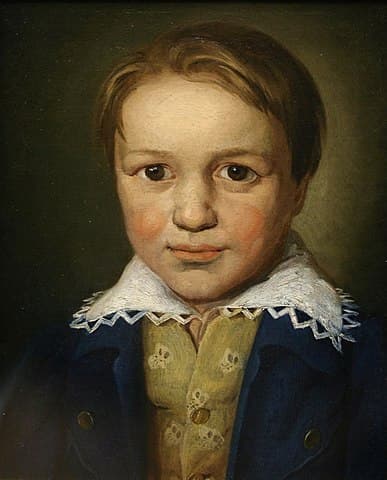
Ludwig van Beethoven at 13 years old
Let us conclude this first episode dedicated to child composers with Ludwig van Beethoven (1770-1827). Many of his childhood compositions are said to be derivative of works by Mozart, however, Beethoven employs a much wider dynamic range, and much more virtuosic piano figuration. When he attached a dedicatory letter to the 1783 original edition of his three early piano sonatas (WoO 47), he explained that his Muse had commanded him to write down his music. “My Muse wished it, and I obeyed and wrote.” According to Cooper, “This sense of compulsion experienced by some composers provides further evidence for an innate, genetic predisposition to composition in a few rare children, rather than a response to an external incentive.” Beethoven’s E-flat Major Piano Concerto WoO 4, was written when the composer was fourteen years old. To enhance his son’s reputation as a prodigy, Beethoven’s father claimed that the work was written when the boy was only 12. “Beethoven was not aware of this false claim until he was 40 years old, by which time he had long since disowned the piece.” The music for this work survives in only the solo piano part, and various scholars, musicologists, and performers have since reconstructed the entire concerto. A scholar writes, “While it is difficult to regard the E-flat concerto in its standard arrangement as an authentic piano concerto by Beethoven, the parentage of the solo piano manuscript is undisputed.” Please join us next time, when we will showcase early compositions by Mozart, Mendelssohn, Clara Wieck, Richard Strauss, and others.
Thursday, August 24, 2023
The pianist who dared to challenge Beethoven to a musical duel in Vienna – and his fate…
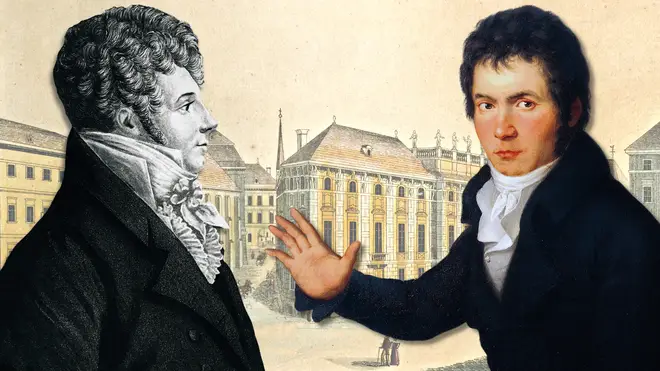
By John Suchet
Here’s what happens when you challenge one of history’s greatest composer-pianists to an improvisation battle. Spoiler: it didn’t go too well for Mr Steibelt...
Classic FM presenter and Beethoven specialist John Suchet tells one of the most remarkable and entertaining stories about the mammoth musical melee that took place in the cultural centre of Europe.
Who was Daniel Steibelt?
A native of Berlin, Daniel Steibelt was one of Europe’s most renowned piano virtuosos. He was a typical Prussian – formal, correct, proper. In 1800 he came to Vienna, no doubt with the aim of advancing his musical reputation.
It was quickly agreed among the city’s musical patrons that Steibelt should compete against Beethoven in an improvisation contest.

Daniel Steibelt—Piano Concertos Nos 3, 5 & 7—Howard Shelley (piano)
What was an improvisation contest?
These improvisation contests were a popular form of entertainment among Vienna’s aristocracy. One nobleman would support one virtuoso pianist, another would support the other. In the salon of one of the noblemen, the two pianists would compete with each other, each setting the other a tune to improvise on.
The playing would go back and forth, increasing in intensity, until a winner was declared. In his early years in Vienna, Beethoven was made to take on the city’s best talent and he quickly saw them off.
It was agreed that Prince Lobkowitz would sponsor Steibelt and Prince Lichnowsky sponsor Beethoven, the improvisation contest to take place in Lobkowitz’s palace.
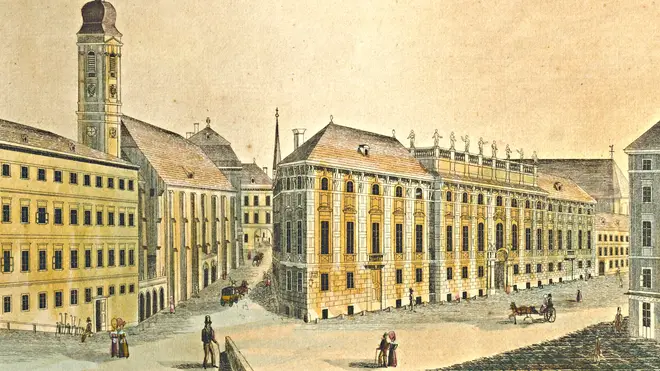
Beethoven and Steibelt’s duel
As the challenger, Steibelt was to play first. He walked to the piano, tossing a piece of his own music on the side, and played. Steibelt was renowned for conjuring up a “storm” on the piano, and this he did to great effect, the “thunder” growling in the bass.
He rose to great applause, and all eyes turned to Beethoven, who took a deep breath, slowly exhaled, and reluctantly – to the collective relief of everyone present – trudged to the piano.
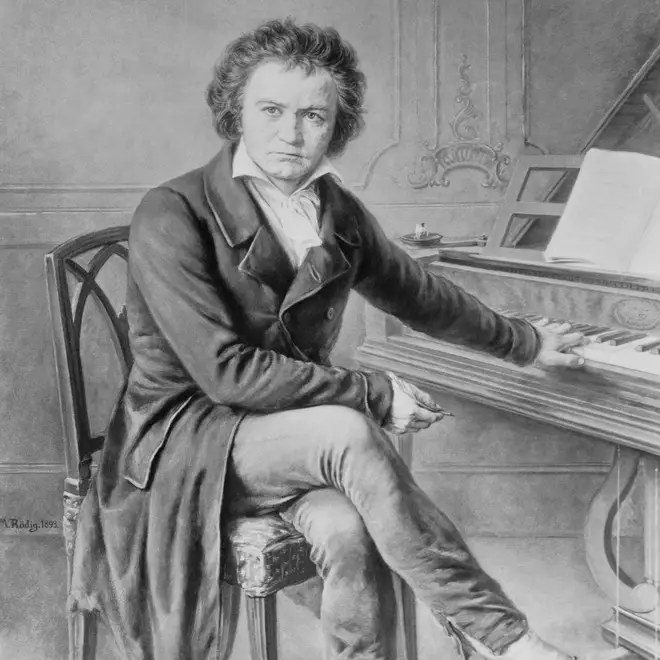
Beethoven’s turn to play
When he got there he picked up the piece of music Steibelt had tossed on the side, looked at it, showed it the audience, and turned it upside down!
He sat at the piano and played the four notes in the opening bar of Steibelt’s music. He began to vary them, embellish them, improvising on them with both great virtuosity and supreme musical insight.
He played on, imitated a Steibelt “storm”, unpicked Steibelt’s playing and put it together again, parodied it and mocked it.

Beethoven - Moonlight Sonata, 3rd Mvt. (Marnie Laird - Brooklyn Classical)
Steibelt makes a dramatic exit…
Steibelt, realising he was not only being comprehensively outplayed but humiliated, strode out of the room. Prince Lobkowitz hurried after him, returning a few moments later to say Steibelt had said he would never again set foot in Vienna as long as Beethoven lived there.
Beethoven lived in Vienna for the rest of his life, and Steibelt kept his promise – he never returned.
Beethoven was never again asked to take on any piano virtuoso – his position as Vienna’s supreme piano virtuoso was established. And those four notes – the first bar of Steibelt's music? They became, in time, the impetus that drives the Eroica Symphony.

Beethoven: 3. Sinfonie (»Eroica«) ∙ hr-Sinfonieorchester ∙ Andrés Orozco-Estrada
Listen to ‘Classical Legends with John Suchet’ on Classic FM this Sunday night at 9pm, or catch up on Global Player.
Who was Lili Boulanger?
Meet the inspiring composer who died tragically young
Lili Boulanger was one of the most exciting composers of the early 20th century, until she died at just 24. Here’s everything you need to know about her life, music, and how her influence lives on today.
A promising talent from a very early age, Boulanger was a multi-instrumentalist and pioneering composer, who shared her musical genius with the world right up to her untimely death in 1918, at just 24 years old.
Lili was part of the musically-gifted Boulanger family
Lili Boulanger was born to a prodigious family of musicians, so it’s no wonder she followed the family tradition with several generations’ worth of musical talent flowing through her veins.
Her mother, Raissa Myshetskaya, was a Russian princess who studied at the Paris Conservatoire. It was there that she fell in love with her teacher, Ernest Boulanger.
Boulanger himself was a conductor and composer, and the descendant of fine musical stock: his father, Frédéric was an acclaimed cellist, and his mother, Juliette, was a singer.
Lili Boulanger was a child prodigy
Lili Boulanger was just two years old when she began to be noticed for her musical prowess. The great composer Gabriel Fauré, a friend of the family, spotted that she had perfect pitch, and the tot was able to sing melodies by ear.
Her parents nurtured her abilities and encouraged a prestigious music education. Before the age of five she was accompanying her older sister, Nadia, to lessons at the Paris Conservatoire. Later she would attend independently, taking classes in music theory and the organ.
Boulanger also played piano, violin, cello and harp, as well as singing.
The first woman to win the Prix de Rome
In 1912, Lili Boulanger entered the Prix de Rome – the most prestigious honour for artists at the time. First awarded in the 17th century, the prize allowed the winner to live in Rome for three to five years, all expenses paid.
With categories in painting, sculpture, architecture and engraving, the first prize for musical competition was awarded in 1803 to Albert Androt.
Among its winners are some of Europe’s finest composers: Georges Bizet, Hector Berlioz, Claude Debussy, and even Lili’s own father, Ernest, in 1835 at the age of 20.
However, her 1912 entry was ill-fated. Boulanger collapsed from illness during her performance, and was unable to complete her entry. Not easily discouraged, Boulanger attempted once more in 1913, then aged 19, and won.
Her victory made her the first woman to win the Prix de Rome, though the judges couldn’t quite bear to let her enjoy the honour on her own. So they also awarded first prize that year to Claude Delvincourt.

Lili Boulanger: D'un matin de printemps / Cristian Măcelaru and Seattle Symphony
She wrote the cantata ‘Faust et Hélène’ in just four weeks
Faust et Hélène is the piece that gave the Prix de Rome judges no choice but to give her the award.
The rules of the competition stated that the piece had to be written in four weeks – so that’s what the precocious 19-year-old Lili did.
The cantata is 30 minutes long and is written for a full orchestra, telling the story of Faust, the man seduced by the power offered by the demon Mephistopheles.
Boulanger’s retelling of the German legend contains flavours of Wagner and Debussy, and it’s no surprise it won the most prestigious prize of its day. Just listen to this:

Boulanger: Faust et Hélène - Radio Filharmonisch Orkest o.l.v. Karina Canellakis - Live concert HD
A prolific composer and diligent worker, Boulanger continued writing music on her sickbed. Her final piece, a haunting and evocative ‘Pie Jesu’, was completed in her 24th year in 1918.
Initial sketches of the work have been found in the composer’s composition book, used between 1909 and 1913. It was completed with the help of her sister Nadia, who wrote out the work as it was dictated to her.
Lili Boulanger’s illness and death
Much of Lili Boulanger’s short life was afflicted by tragedy. At just two years old, she contracted bronchial pneumonia, an infection of the lungs.
Boulanger recovered, but her immune system was irrevocably weakened by the illness and she suffered from chronic illness for the remainder of her life.
In 1900, when she was just seven years old, her father, who had been 77 at her birth, died. His death affected Boulanger, who was very close to her father, greatly, and much of her work would deal with themes of loss.
In 1918, Boulanger died from intestinal tuberculosis which arose from her life-long health complications. She was buried in the Cemetery of Montmartre, where she was joined by her sister, Nadia, in 1979, as well as both of their parents.
Lili Boulanger’s legacy
Despite such a brief career, cut short by her premature death, Lili Boulanger’s legacy lives on today through both her own music, and that of many other eminent composers.
Lili’s sister, Nadia, who was a fine composer in her own right, was so affected by her sibling’s death that she deemed her own works “useless” and turned her complete attention to teaching, hoping to continue her sister’s legacy through pedagogy.

Over a lifetime of nurturing young musical talent, Nadia Boulanger’s students became some of the 20th century’s most famous composers and conductors, from Aaron Copland and Leonard Bernstein to Quincy Jones and Daniel Barenboim.
So although Lili Boulanger’s young death may have robbed us from plenty of brilliant music, perhaps if she had lived we may never have had West Side Story, ‘Fanfare for the Common Man’, or the West-Eastern Divan Orchestra.
